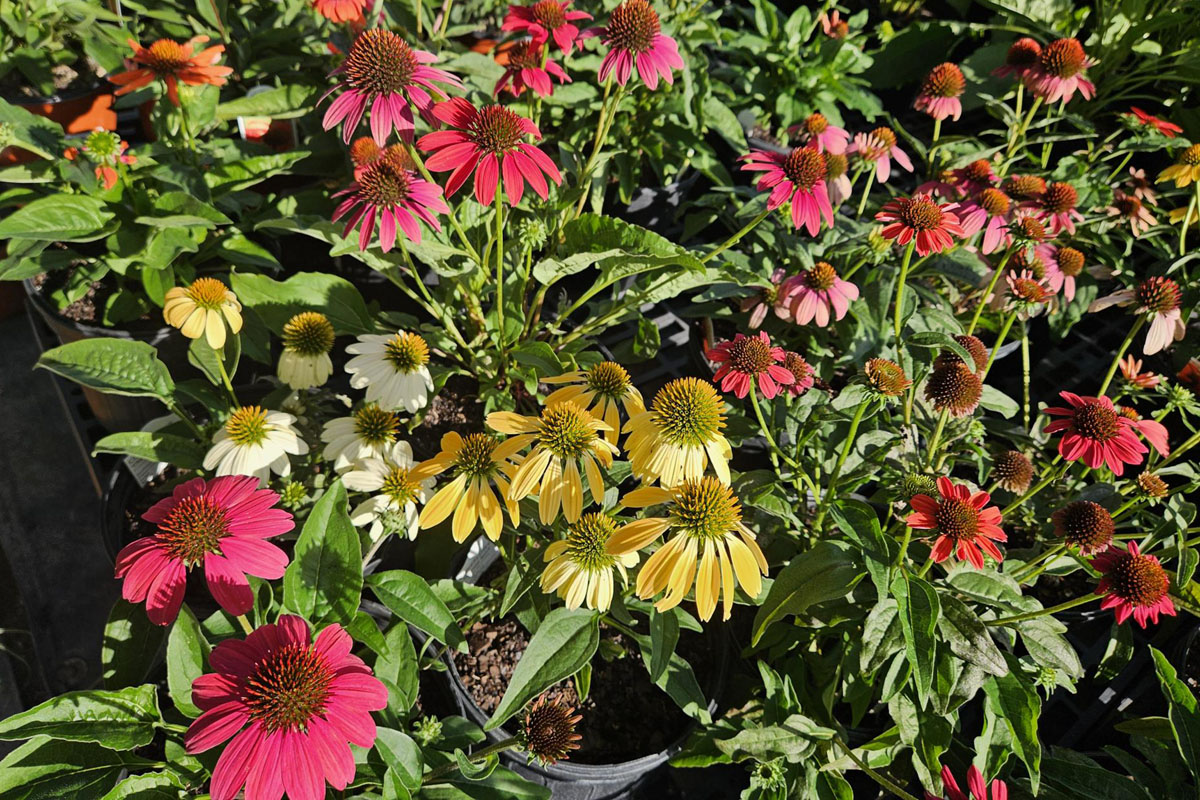Top Stories
Gardening Tips for Late Summer: Key Care Strategies Revealed

As August progresses, maintaining garden health becomes increasingly important, particularly as temperatures stabilize in the 70s. During the week of August 21, 2025, the Lazy Berkshire Gardener focused on essential tasks such as watering and weeding to ensure plants thrive amid fluctuating weather conditions. The dry soil presents challenges, making it crucial to prioritize preventing weeds from flowering while nurturing vegetable gardens and newly planted perennials.
Despite the heat, August-blooming perennials can flourish if properly cared for. These plants often exhibit drought tolerance, which is beneficial during dry spells. The gardener is particularly interested in adding new coneflower plants, specifically the hybrid Echinacea ‘Cheyenne Spirit’. This variety is notable for producing flowers in multiple colors, including white, peach, yellow, orange, pink, and deep burgundy. What blooms yellow one year may surprise with burgundy hues the next, providing variety and vibrancy to the flower beds.
The coneflower complements other late summer plants, such as fall asters and goldenrod. The Solidago spp. species, known for its role in supporting pollinators, is a staple in the New England ecosystem. This native plant can thrive in various soil types and conditions, contributing significantly to local biodiversity. Research by Doug Tallamy indicates that Solidago supports over 100 species of moths and butterflies, earning it a high pollinator value rating from the Xerces Society.
In terms of maintenance, the gardener noted that the second wave of Shasta daisies has faded and has been pruned to maintain a tidy appearance. This practice encourages a healthier and more aesthetically pleasing garden. For those planning ahead, garden centers are currently stocking fall-blooming crocus bulbs, known as Colchicum. These unique bulbs yield large blooms in the fall, adding unexpected color after the summer flowers have faded.
Watering practices also play a critical role in the garden’s success. Observations revealed that inconsistent watering led to some carrots splitting. Early germination was promising, but the lack of consistent moisture during peak heat caused issues. The gardener plans to harvest the mature carrots while allowing younger ones to continue growing, highlighting the importance of monitoring moisture levels.
Lettuce and greens have begun to bolt, a process that often results in bitterness. To salvage the remaining crop, cutting back the stems to just above soil level helps improve flavor. After soaking the cuttings in cold water, the bitterness can be reduced, making them suitable for salads.
The gardener is also attentive to the raspberry canes, which are being watered every other day during the heat. Bees are visiting the plants, signaling healthy pollination, and the absence of Japanese beetles suggests that the worst of the pest damage is over. Late-season raspberries are expected to be ready for harvest by early September.
In a positive turn, the peach trees have been freed from protective polyester fabric. This precaution was taken to prevent defoliation caused by Japanese beetles. While the trees may appear slightly warped, they are recovering well, and the gardener anticipates a fruitful autumn.
Tomatoes are ripening rapidly, and the gardener suggests various ways to utilize them, from fresh salads to homemade sauces. An efficient method of preserving summer tomatoes involves roasting them in the oven, transforming them into a flavorful spread that can be enjoyed for weeks.
As August continues, there are additional considerations for garden maintenance. Transitioning houseplants back indoors requires careful planning, particularly regarding pest prevention. It is recommended to treat outdoor houseplants with insecticidal soap, ensuring a healthy return to indoor environments.
Drying onions, shallots, and garlic properly before storing is essential, as is allowing grapes to ripen fully on the vine. The gardener encourages letting some dill and coriander seeds fall to the ground to foster new crops, promoting sustainability.
The Lazy Berkshire Gardener embraces a low-maintenance approach to gardening, focusing on techniques that yield significant results with minimal effort. By observing the landscape and allowing nature to take its course, this gardening philosophy prioritizes enjoyment over strenuous labor, creating a thriving and beautiful garden.
-

 Entertainment2 months ago
Entertainment2 months agoAnn Ming Reflects on ITV’s ‘I Fought the Law’ Drama
-

 Entertainment3 months ago
Entertainment3 months agoKate Garraway Sells £2 Million Home Amid Financial Struggles
-

 Health2 months ago
Health2 months agoKatie Price Faces New Health Concerns After Cancer Symptoms Resurface
-

 Entertainment2 months ago
Entertainment2 months agoCoronation Street’s Carl Webster Faces Trouble with New Affairs
-

 Entertainment2 months ago
Entertainment2 months agoWhere is Tinder Swindler Simon Leviev? Latest Updates Revealed
-

 Entertainment3 months ago
Entertainment3 months agoKim Cattrall Posts Cryptic Message After HBO’s Sequel Cancellation
-

 Science4 weeks ago
Science4 weeks agoBrian Cox Addresses Claims of Alien Probe in 3I/ATLAS Discovery
-

 Entertainment2 months ago
Entertainment2 months agoOlivia Attwood Opens Up About Fallout with Former Best Friend
-

 Entertainment3 months ago
Entertainment3 months agoMarkiplier Addresses AI Controversy During Livestream Response
-

 Entertainment3 months ago
Entertainment3 months agoMasterChef Faces Turmoil as Tom Kerridge Withdraws from Hosting Role
-

 Entertainment4 months ago
Entertainment4 months agoSpeculation Surrounds Home and Away as Cast Departures Mount
-

 World2 months ago
World2 months agoCole Palmer’s Mysterious Message to Kobbie Mainoo Sparks Speculation









